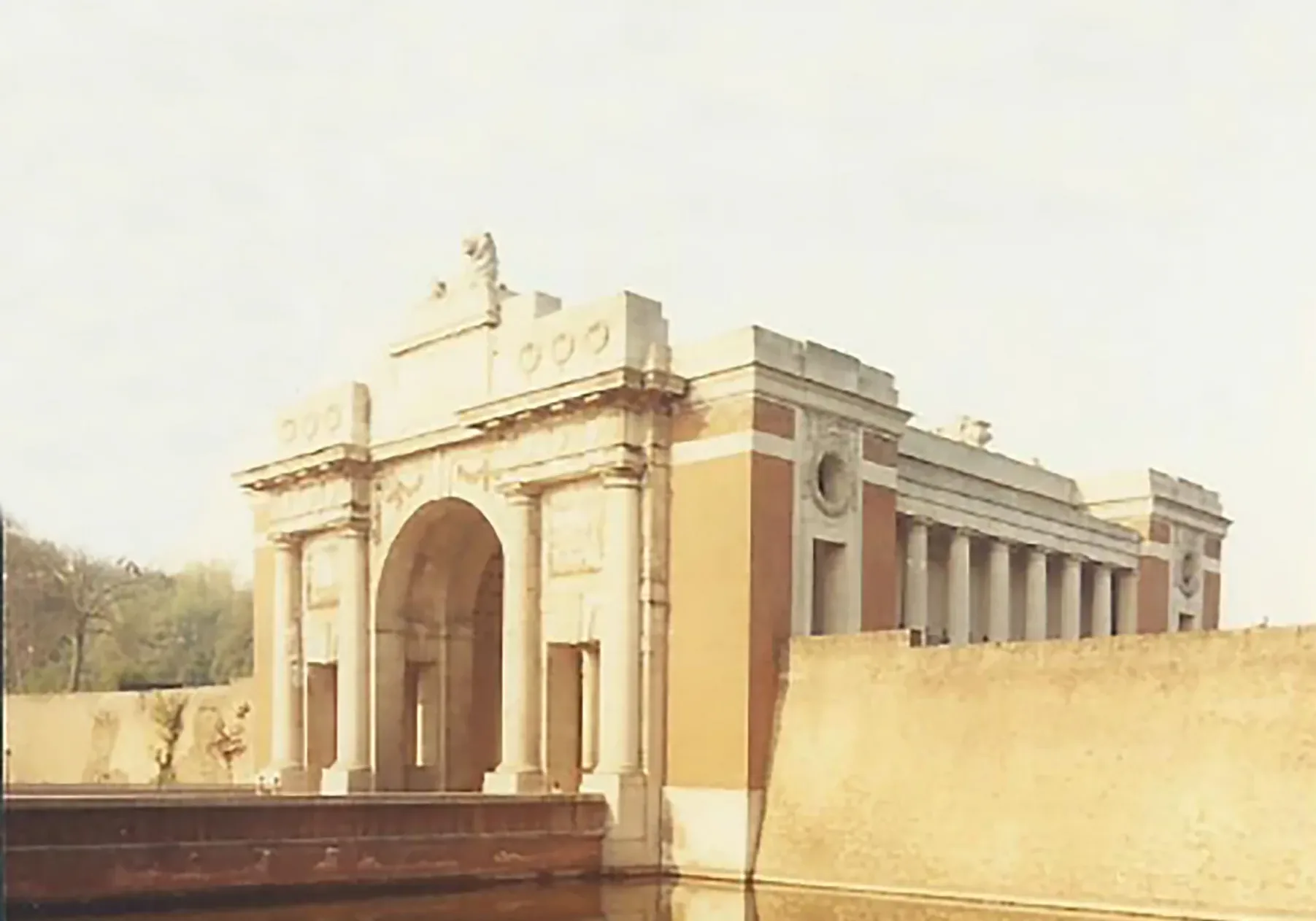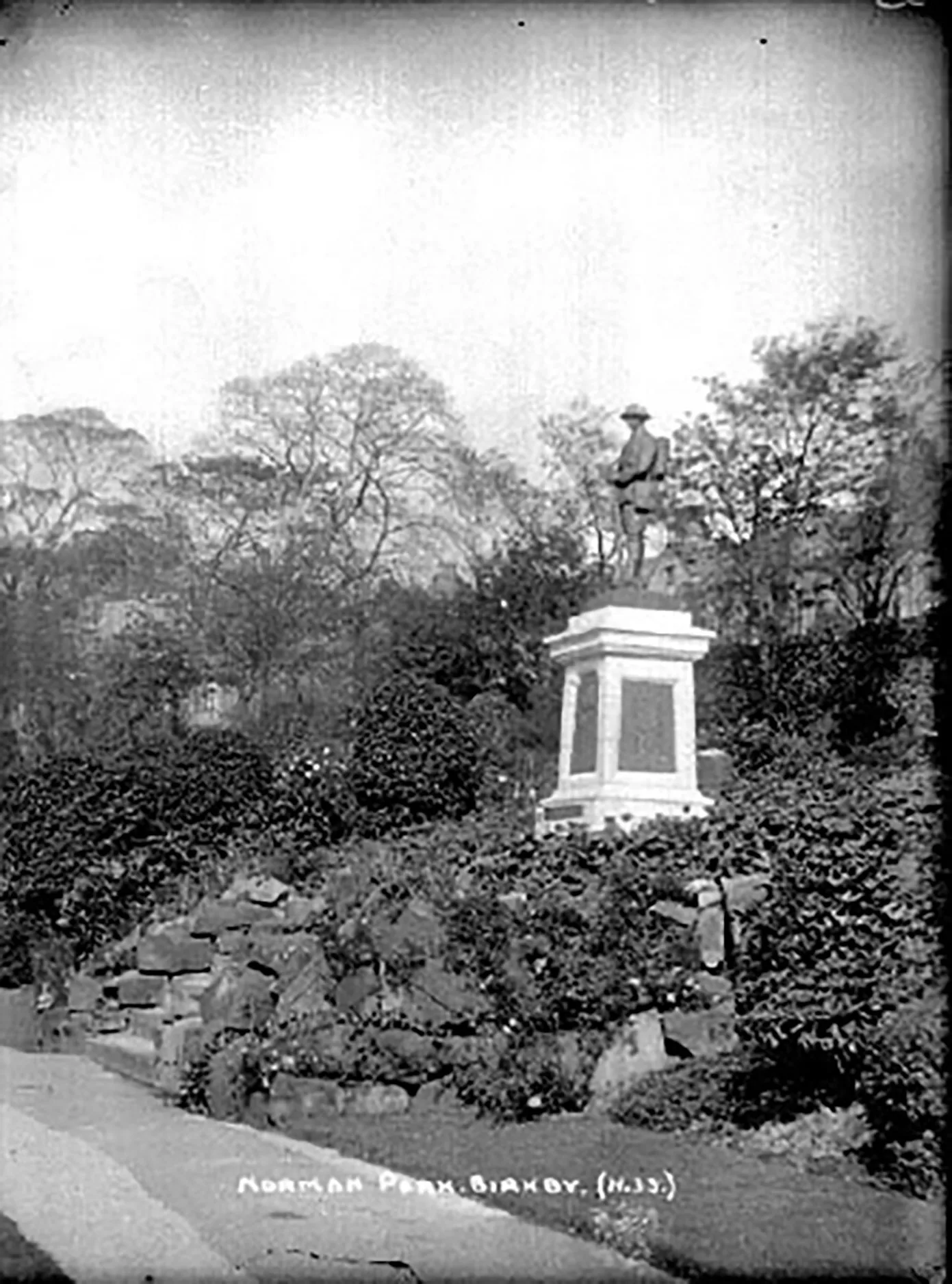
The Name on the Menin Gate
by David Pogson
They went with songs to the battle; they were young, Straight of limb, true of eye, steady and aglow, They were staunch to the end against odds uncounted; They fell with their faces to the foe. From ‘For the Fallen’ by Laurence Binyon
Benjamin Pogson lived only a short life of 20 years. There is only one known photograph of him. He had no wife and no children. He never met any of his nephews and nieces. He had no funeral, no mourners present, and no known grave. Apart from his name on two memorials, his life goes relatively unrecorded. And yet, his relatives, their descendants and the rest of the nation owe him a tremendous debt, one that can never be repaid.
Ben was born at 20 Arthington Grove, Hunslet, part of Leeds, on the 11th of November 1894, one of eight children to Edward Pogson and Mary Sheard from Hunslet.
THE MOVE TO HUDDERSFIELD

Edward Pogson (centre) with probably his youngest daughters, Ida and Angelina, at Clement Street, Birkby, Huddersfield, in the early/mid-1920s.
At some time in 1913, the entire family relocated to Huddersfield. The relocation was not surprising. Father Edward strongly supported the Trade Union movement and was a known agitator for workers’ rights. Family stories suggest that he found it hard to secure work in the leather industry because of his union activity.
The move to Huddersfield brought changes, new jobs and new directions. Maybe Ben was finding those changes hard to adjust to after only a short time in a strange town; he had left his friends behind. Perhaps he was struggling to find work and felt it was time to make changes, too. It is not certain when he joined the army.
The most likely possibility is that he volunteered as a reservist in May 1913, shortly after the move from Leeds and well before the outbreak of war.
What is certain is that by the outbreak of war on the 4th of August 1914, with the heavy casualty numbers being kept a strict secret from the press, at nineteen years of age, Ben had already joined the 3rd Battalion (Special Reserve) of the Duke of Wellington’s (West Riding) Regiment (known as ‘the Dukes’ with a base in Huddersfield but with its home barracks in Halifax) as an infantryman.
His Battalion was mobilised for war service on the 8th of August 1914.
THE START OF WAR

The only known photo of Benjamin Pogson. Press item from Page 3 of the Huddersfield Daily Examiner
of Thursday, 10th December 1914, courtesy of
Sandra Stocks. (Public domain by reason of age.) His
Regimental Cap badge is just about visible.
The plan of the French and British to advance into Germany was quickly frustrated by the Germans, who were sweeping through neutral Belgium. On 24th August, six German division came up against the two divisions of II Corps at Mons. Despite their overwhelming superiority, the German attack crumpled in the face of the superb rifle fire from the 3rd and 5th Divisions regiments. A retreat towards Paris followed Mons, but the tide was turned at the Marne, and the Germans withdrew. The race to the sea began as each army tried to outflank the other.
It is impossible to say exactly if or where Ben fought in those early weeks during September and October, but records show that he formally transferred to D Company, 2nd Battalion, as a front-line soldier on the 23rd of September 1914. Furthermore, what is also certain is that Ben fought in the brutal conflict, which became known as the 1st Battle of Ypres in November 1914, only two months after arriving in Flanders.
THE FIRST BATTLE OF YPRES
On October 19, 1914, near the Belgian city of Ypres, the Flemish ancient town with its fortifications guarding the ports of the English Channel and access to the North Sea beyond, Allied and German forces began the first battle of Ypres. It was an attempt to control the city and its advantageous position on the north coast of Belgium.

The Duke of Wellington’s (West Riding) Regiment cap badge
THE OUTCOME OF THE FIRST BATTLE OF YPRES
The Battle lasted from the 19th of October to the 22nd of November. It is generally regarded as having achieved an indecisive result because it did not produce a positive outcome for either side. It is estimated that Britain suffered around 58,000 casualties in the battle, with nearly 8,000 deaths; that France experienced approximately 50,000 casualties, while Belgium endured over 21,000 and Germany suffered about 130,000. Winter arrived on the 12th of November, and the fighting tailed off.

British soldiers marching through a town – Cassel in France on their way to the Flanders front in late 1914. Source: Copyright IWM Q109652
The weather became much colder, with rain from the 12th to the 14th of November and a little snow on the 15th. The nights were frosty, and on the 20th of November, the ground was covered by snow. Frostbite cases added to the existing stressful situation endured by troops occupying trenches half-full of freezing water, falling asleep standing up and being shelled and sniped at from opposing trenches only 100 yards away. However, Ben Pogson never experienced that winter.
WHAT HAPPENED TO BENJAMIN POGSON?
It should be borne in mind that the most significant number of casualties in World War One were caused by artillery fire. It is quite possible that Ben was killed in the intense bombardment on the morning of the 11th of November.
If there was a birthday package from home for him at the next mail call, it remained unclaimed.
However, unlike much of the fighting elsewhere, this was not solely an artillery battle. At Nonne Bosschen, the fighting was mainly rifle fire and then desperate hand-to-hand combat in the trenches. Ben was with D Company, occupying the forward trenches overrun by the Prussian Guard, where those who did not escape were either killed or captured. So, there is every possibility that he may have died in that close-quarter fighting when the enemy attacked those trenches around 7:30 a.m. or in the woods if he survived the retreat from the trenches. Whether he was covered by debris during the early shelling or killed later in the hand-to-hand fighting and buried in a temporary grave is not known, but either way, he was recorded as being killed in action.

Typical makeshift battlefield grave in a shell hole (this one on the Somme, not Ypres, but it illustrates the circumstances). Source: Copyright IWM Q4316
Almost inevitably, along with the graves of so many others, the subsequent movement of troops backwards and forwards across that location, including the 2nd and 3rd Battles of Ypres, over the next four years of war, turning it from fields and woods into a sea of mud, ensured that his final resting place remained unknown.
He died aged 20 on his birthday on the 11th of November 1914, only two months after he arrived in France; he was still not old enough to vote. It was that day that the regiment won the Battle Honour for Nonne Bosschen.
If there was a birthday package from home for him at the next mail call, it remained unclaimed.
On the 25th of October 1916, Mary Pogson, Ben’s mother, was awarded a Dependent’s Pension of five shillings per week, payable from the 28th of December 1915, resulting from Ben’s death.
AFTER THE WAR
For his contribution, Ben was posthumously awarded his medals around the 19th of February 1921.
These were the 1914 ‘Mons Star’ and clasp, the British War Medal and the Allied Victory Medal. The clasp bore the dates 5 August – 22 November 1914 and was awarded to all men who had been under fire in France or Belgium on or between those dates.

War Memorial at Norman Park, Birkby. Photo from Roberta Walker from ‘Old Photos of Huddersfield and Area’ Facebook page
The people of Huddersfield erected a war memorial at Norman Park in the Fartown and Birkby area, not far from Clement Street, where Ben had lived.
With others, his name is recorded on that memorial. Edward, Mary Pogson, and the rest of the family (except Maud) must have been amongst the large crowd attending its unveiling on Saturday, the 2nd of April 1921.
On the 24th of July 1927, Field Marshall Lord Plumer unveiled the Menin Gate Memorial to the Missing at Iepers, West Vlaanderen, in Belgium. ln company with over fifty-four thousand others, the name of Benjamin Pogson was carved on that memorial (Addenda Panel 58). As Plumer said at that ceremony,
“He is not missing; he is here.”
NorthernLife Nov/Dec 23




